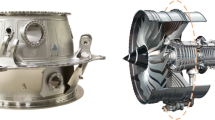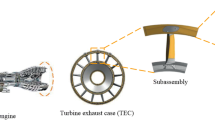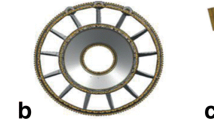Abstract
In this work constitutive models suitable for thermo-mechanical forming of the titanium alloy Ti-6Al-4V are evaluated. A tool concept for thermo-mechanical forming of a double-curved sheet metal component in Ti-6Al-4V is proposed. The virtual tool design is based on finite element (FE) analyses of thermo-mechanical sheet metal forming in which two different anisotropic yield criteria are evaluated and compared with an isotropic assumption to predict global forming force, draw-in, springback and strain localisation. The shape of the yield surface has been found important and the accuracy of the predicted shape deviation could be slightly improved by including the cooling procedure. The predicted responses show promising agreement with the corresponding experimental observations when the anisotropic properties of the material are considered.






















Similar content being viewed by others
References
Materials Properties Handbook: Titanium alloys, ASM International (1994), pp 483–636.
Lütjering G, Williams JC (2003) Titanium. Springer-Verlag Berlin, Heidelberg
Semiatin SL, Seetharaman V, Weiss I (1998) Mater Sci Eng, A A243:1–24
Ding R, Guo ZX, Wilson A (2002) Mater Sci Eng, A 327:233–245
Follansbee PS, Grey GT III (1989) An analysis of the low temperature, low and high strain. Rate deformation of Ti-6Al-4V. Metall Trans A 20A(5):863–874
Nemat-Nasser S, Guo W-G, Nesterenko VF, Indrakanti S, Gu Y-B (2001) Dynamic response of conventional and hot isostatically pressed Ti-6Al-4V alloys: Experiments and modeling. Mech Mater 33(8):425–439, ISSN: 0167–6636
Picu RC, Majorell A (2002) Mechanical behaviour of Ti-6Al-4V at high and moderate temperatures—Part II: constitutive modelling. Mater Sci Eng A326:306–316
Lee WS, Lin MT (1997) The effects of strain rate and temperature on the compressive deformation behavior of Ti-6Al-4V alloy. J Mater Proc Tech 71:235–246
Khan AS, Suh YS, Kazmi R (2004) Quasi-static and dynamic loading responses and constitutive modeling of titanium alloys. Int J Plast V20:2233–2248
Khan AS, Kazmi R, Farrokh B (2007) Multiaxial and non-proportional loading responses, anisotropy and modelling of Ti-6Al-4V titanium alloy over a wide ranges of strain rates and temperatures. Int J Plast V23:931–950
Ding R, Guo ZX, Qian M (2007) Computation Materials Science 40:201–212
Wagoner AJ, Bull CW, Kumar KS, Briant CL (2003) Metallurgical and Materials Transactions A 34(2):295–306
Lee W-S, Lin M-T (1997) J Mater Process Technol 71(2):235–246
Semiatin SL, Bieler TR (2001) Metallurgical and Materials Transactions A 32(7):1787–1799
Hill R (1950) The mathematical theory of plasticity. Clarendon, Oxford
Jansson M, Nilsson L, Simonsson K (2005) On constitutive modelling of aluminium alloys for tube hydroforming applications. Int J Placticity 21:1041–1058
Lademo OG, Hopperstad OS, Langset M (1999) An evaluation of yield criteria and flow rules for aluminium alloys. Int J Plasticity 15:191–208
Barlat F, Lian J (1989) Plasticity behaviour and strechability of sheet metals Part I: a yield function for orthotropic sheets under plane stress condition. Int J Plasticity 5:51–66
Hosford W (1979) On the yield loci of anisotropic cubic metals. 7th North American Metalworking Conf. SME, Dearborn, MI, pp 191–197
Barlat F, Brem JC, Yoon J, Chung WK, Dick RE, Lege DJ, Pourboghrat F, Choi S-H, Shu E (2003) Plane stress yield function for aluminium alloy sheet—Part1: Theory. Int J Plasticity 19:1297–1319
Barlat F, Aretz JCH, Yoon W, Karabin K, Breem ME, Dick RE (2005) Linear transformation-based anisotropic yield functions. Int J Plasticity 21:1009–1039
Cazacu O, Barlat F (2006) Orthotropic yield criterion for hexagonal closed packed metals. Int J Plasticity 22:1171–1194
Hamilton CH (1989) Superplacticity and superplastic forming. TMS-AIME, Warrendale
Materials Properties Handbook: Titanium alloys (1994) ASM International, pp 483–636
Kong TF, Chan LC, Lee TC (2008) Numerical and experimental investigation of preform design in non-axisymmetrical warm forming. Int J Adv Manuf Technol 37:908–919
Lai CP, Chan LC, Chow CL (2007) Effects of tooling temperature on formability of titanium TWBs at elevated temperatures. J Materials Processing Technology 191:157–160
Lai CP, Chan LC, Chow CL (2007) Warm forming simulation of titanium tailor-welded blanks with experimental verification, CP908, NIMIFORM ’07. Materials Processing and Design, Simulation and Applications, pp 1621–1626
Chen F-K, Chiu K-H (2005) Stamping formability of pure titanium sheets. J Mat Proc Tech 170:181–186
Satoh J, Gotoh M, Maeda Y (2003) Stretch-drawing of titanium sheets. Journal of Materials Processing Technology, v 139, n 1–3 SPEC, Aug 20, pp 201–207, ISSN: 0924–0136
Shipton MH, Roberts WT (1991) Hot deep drawing of titanium sheet. Mater Sci Technol 7(6):537–540, ISSN: 0267–0836
Odenberger E-L, Hertzman J, Thilderkvist P, Merklein M, Kuppert A, Stöhr T, Lechler J and Oldenburg M (2012) Thermo-mechanical sheet metal forming of aero engine components in Ti-6Al-4V—PART 1: Material characterisation. Int. Journal of Material Forming. doi:10.1007/s12289-012-1093-8
Odenberger E-L, Jansson M, Thilderkvist P, Gustavsson H, Oldenburg M (2008) A short lead time methodology for design, compensation and manufacturing of deep drawing tools for Inconel 718, IDDRG 2008 Conference, Best in Class Stamping, pp 697–708
Odenberger E-L, Oldenburg M, Thilderkvist P, Stoehr T, Lechler J, Merklein M (2011) Tool development based on modeling and simulation of hot sheet metal forming of Ti-6Al-4V titanium alloy. J Mater Process Technol 211:1324–1335
Hansson P (2006) TOOLOX—The Multi-purpose Pre-hardened Tool Steels, 2nd International Conference on Accuracy in Forming Technology ICAFT, pp 183–200
Cleveland RM, Ghosh AK (2002) Inelastic effects on springback in metals. Int J Plast 18:769–785
Eggertsen P-A, Mattiasson K (2010) On constitutive modeling for springback analysis. Int J Mech Sci 52:804–818
Vrh M, Halilovič M, Štok B (2011) The evolution of effective elastic properties of a cold formed stainless steel sheet. Exp Mech 51:677–695
Hallquist JO (2006) “LS-DYNA Theory Manual” Livermore Software Technology Corporation, Livermore
LS-DYNA Keyword User’s Manual (2007) Volume 1, v971, Livermore Software Technology Corporation, Livermore
Friedman PA, Pan J (2000) Effects of plastic anisotropy and yield criteria on prediction of forming limits. Int J Mechanical Science 42:29–48
Sigvant M, Mattiasson K, Larsson M (2008) The definition of incipient necking and its impact on experimentally or theoretically determined forming limit curves, IDDRG 2008 Conference. Olofström, Sweden, pp 207–218
Acknowledgements
The research funding by VINNOVA (grant 2009–01365) and Volvo Aero Corporation, Engineering Research Nordic AB, concerned staff at ITE Fabriks AB and Industrial Development Centre in Olofström AB are gratefully acknowledged.
Author information
Authors and Affiliations
Corresponding author
Rights and permissions
About this article
Cite this article
Odenberger, EL., Schill, M. & Oldenburg, M. Thermo-mechanical sheet metal forming of aero engine components in Ti-6Al-4V—PART 2: Constitutive modelling and validation. Int J Mater Form 6, 403–416 (2013). https://doi.org/10.1007/s12289-012-1094-7
Received:
Accepted:
Published:
Issue Date:
DOI: https://doi.org/10.1007/s12289-012-1094-7




